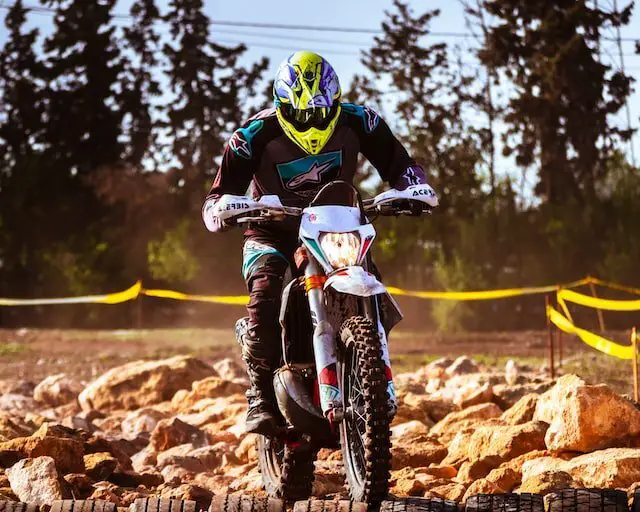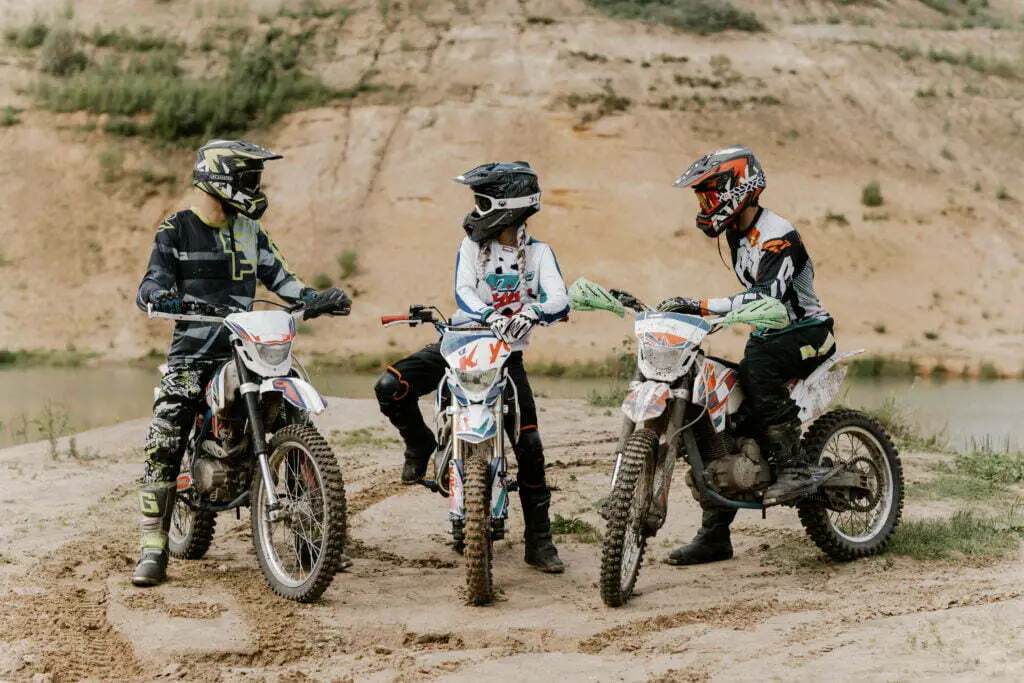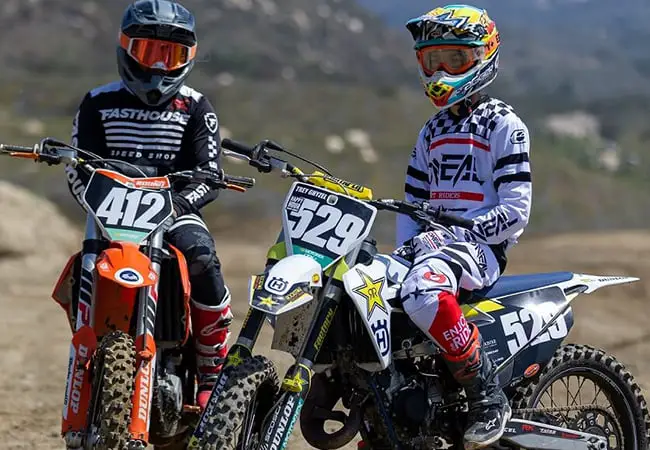I remember how confused I was when I had to figure out what dirt bike gear to buy. Hours of research only left me wondering – what dirt bike gear do I need, and which can I purchase later?
With so many gear options available, choosing which to buy first can be tricky. And if you’re in this confusing state right now, I got you.
Essential dirt bike gear includes a helmet for head protection, goggles to shield your eyes, a neck brace to prevent neck injuries, and a roost or chest protector to protect your chest and vital organs. Finally, motocross boots will offer you ankle and foot protection.
Additionally, you’ll need a dirt bike jersey and pants for a safe and comfortable ride, MX gloves for grip and hand protection, elbow guards for elbow protection, and knee guards or braces for knee protection.
In order to help you make the right buying decisions, I will share with you what the different gears play in your dirt bike experience and how to spot quality gear for your dirt bike setup.
I’ll also share some accessories for extra protection against accidents from off-road riding.
Why invest in dirt bike gear?
Did you know from 2002 to 2006, 9,875 out of 34, 457 off-road injuries were due to dirt bike riding?
[1] Unfortunately, over 50% of dirt bike riders who get hurt have trauma, while 35% have fractures.
The top dirt bike injuries? Fractures, head injuries and concussions, ACL tears, and shoulder dislocations. [2]
One major reason these accidents happen is that riders don’t wear dirt bike helmets.
[3] Wearing the right gear won’t completely protect you, but it can safeguard your body from the worst impact.
A good motocross helmet can cushion your head when you fall or hit another vehicle, while a knee guard can absorb the blow of a crash.
It’s not just about preventing injuries, though.
Riding for hours can cause muscle fatigue and can affect your performance.
[4] Investing in riding gear that fits well and made from breathable materials can reduce fatigue, allowing you to ride more comfortably for longer periods.
Lastly, wearing street-legal dirt bike helmets will keep you safe from accidents and getting fined or receiving worse penalties when you decide to take your dirt bike on the streets.
What dirt bike gear do I need?
If you’re just getting started, it can be overwhelming to determine which gear is essential and which is just nice to have.
But don’t worry, I got your back.
So, let’s start with the must-haves. These are the most significant dirt bike gear you should invest in:
Dirt bike helmet
As a seasoned dirt bike rider, I can tell you that protecting your head is essential.
That’s why you need a high-quality full-face dirt bike helmet. Unlike street helmets, dirt bike helmets are designed to protect riders from impacts and debris encountered on the trail.
The rigid outer shell of a dirt bike helmet is made from materials like polycarbonate, fiberglass, or carbon fiber, which absorb the initial impact of a crash.
The inner liner is made of EPS foam that cushions the head and absorbs shock.
They also have a sun visor that doubles as a roost deflector, and the chin area is more prominent to provide additional protection for the rider’s jaws.
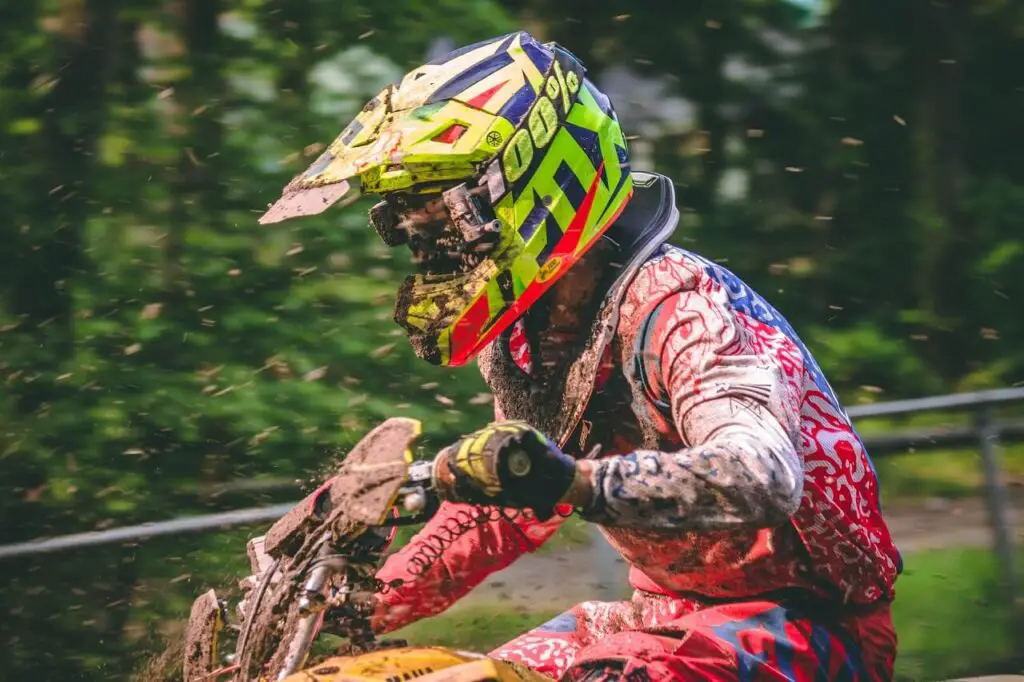
Dirt bike helmets also offer wider peripheral vision for better obstacle awareness on the trail.
Plus, they have proper ventilation to keep you cool and comfortable during long rides.
When buying a dirt bike helmet, always go for DOT-approved ones to ensure you comply with the law.
If your budget allows, invest in a DOT-approved helmet with an ECE or Snell certification for maximum protection.
Remember, your head is priceless, so invest in a quality helmet to keep it safe!
Check out our top 5 dirt bike helmets for beginners.
Dirt bike goggles
If you’re going to ride off-road, you need to protect your eyes as well.
Dirt bike goggles can help protect your eyes from debris such as dirt, rocks, mud, and UV rays.
They’re designed to fit snugly into the open eye area of your helmet, keeping your vision clear and your eyes safe.
When choosing your dirt bike goggles, look for lenses made of polycarbonate or Trivex that are scratch-resistant, fog-resistant, and impact-resistant.
The frame should be made of durable materials like TPU to protect your goggles from getting damaged.
Comfort is also key, so choose goggles with adjustable straps and foam padding to ensure a snug and comfortable fit.
Check out our top 5 dirt bike goggles for beginners.
Motocross boots
It’s also crucial to have proper protection and comfort for your lower legs and feet.
After all, you’ll rely on them to support your weight and help you navigate trails as you ride on tracks or trails.
Dirt bike boots are designed to do just that, with a sturdy high-top design that covers your ankles and provides extra protection for your lower legs.
They’re also designed to give you a secure fit, with buckle or strap closures that keep the boots from coming off during a fall.
Check out our top 5 dirt bike boots for beginners.
Body protection
Now that your head is protected, let’s go over the essentials for protecting your body while dirt bike riding.
Neck brace
When dirt biking, a neck brace can be an essential gear for protecting your neck and spine.
Some riders may find neck braces uncomfortable, but they can significantly reduce the risk of serious injuries like whiplash, spinal cord damage, or paralysis by distributing the force of an impact more evenly across the neck and collarbone.
Today’s manufacturers design neck braces to be low-key and versatile, so you can find one that suits your size perfectly and allows you to move your head freely.
It’s important to check the size and specifications of the neck brace before buying to ensure the proper fit.
Body armor
Body armor is your best bet against getting injured in an accident.
There are two types of armor: the roost protector, which is worn over your dirt bike jersey, and the chest protector, which can be worn under or over your jersey.
Check out our top 5 dirt bike armor for beginners.
Roost protectors
If you’re looking for a lightweight option that won’t restrict your movements while riding, a roost protector is the ideal choice.
It’s designed to deflect roost and debris kicked up by other riders and provides substantial chest coverage while still being well-ventilated.
They’re popular in the dirt bike community, especially for casual rides or bush bashing with friends.
However, a roost protector won’t provide much protection when you crash, since it’s not designed to absorb impact.
They’re more to prevent cuts and bruises, as well as for improved mobility.
Chest protectors
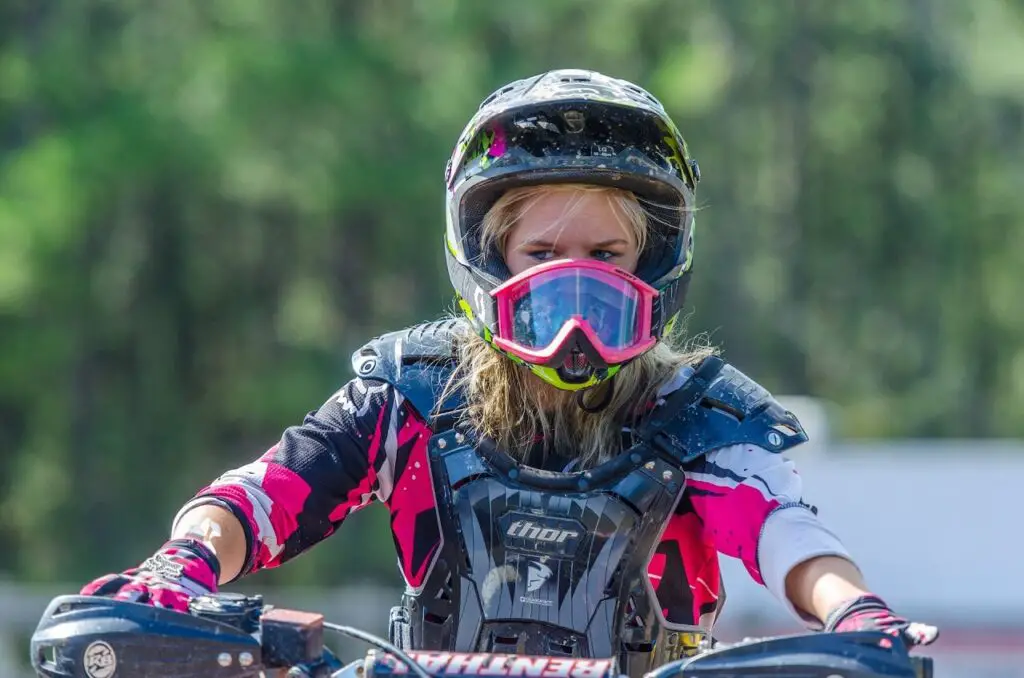
Unlike roost protectors, chest protectors offer heavy-duty protection for your chest, back, ribs, spine, and shoulders.
This is especially relevant during MX races or practices, when you need maximum protection.
However, chest protectors can be heavier and less comfortable than roost protectors.
It may take some time to get used to, but with the right fit and proper ventilation, you’ll hardly even notice it’s there.
Dirt bike jersey and pants
As a dirt bike rider, you might think wearing regular clothes would suffice.
But the truth is, motocross jerseys and pants are specially designed to protect you from crashes, collisions, and falls while providing mobility and ventilation.
Dirt bike jerseys, usually made from nylon, leather, or spandex, can:
- Allow ventilation and absorb sweat
- Protect your skin from UV rays
- Provide padding for shoulders
- Prevent chest chafing
It’s important to avoid buying a loose or baggy motocross jersey and instead find one that fits snugly.
Brands have size charts on their websites, so be sure to check them out.
To complete your protection gear, you’ll also need a pair of dirt bike pants.
There are two types: relaxed and race, each lightweight, durable, flexible, and well-ventilated. Find your right size so they fit snugly on your lower body.
Motocross gloves
I’ve had my fair share of hand injuries, and they can dampen your riding experience.
That’s why I highly recommend buying a pair of dirt bike gloves.
They provide the right amount of padding to prevent cuts, bruises, abrasions, and burns while absorbing vibrations from your hands.
However, you don’t want gloves with too much padding, as it can make them feel stiff.
Look for gloves with dotted silicone layers in the finger areas for excellent grip and a natural curve that matches your grip with your handlebars without the fabric curling up.
Elbow guards
When you fall, which is bound to happen, your elbows take a lot of impact.
That’s why you need elbow guards to reduce the risk of injury.
They may seem small, but they’re just as significant as any other gear.
Elbow guards are made from lightweight and durable materials such as plastic or foam, and they’re designed to cushion the elbow area and absorb impacts from falls or collisions.
They fit snugly around the elbow joint with adjustable straps to keep them in place.
Look for elbow guards made from high-quality materials specifically designed for off-road riding to ensure maximum protection in any type of accident.
Knee protector
I’ve found that knee guards work well for casual riding, but when it comes to competitive riding or more challenging terrain, knee braces are worth the investment.
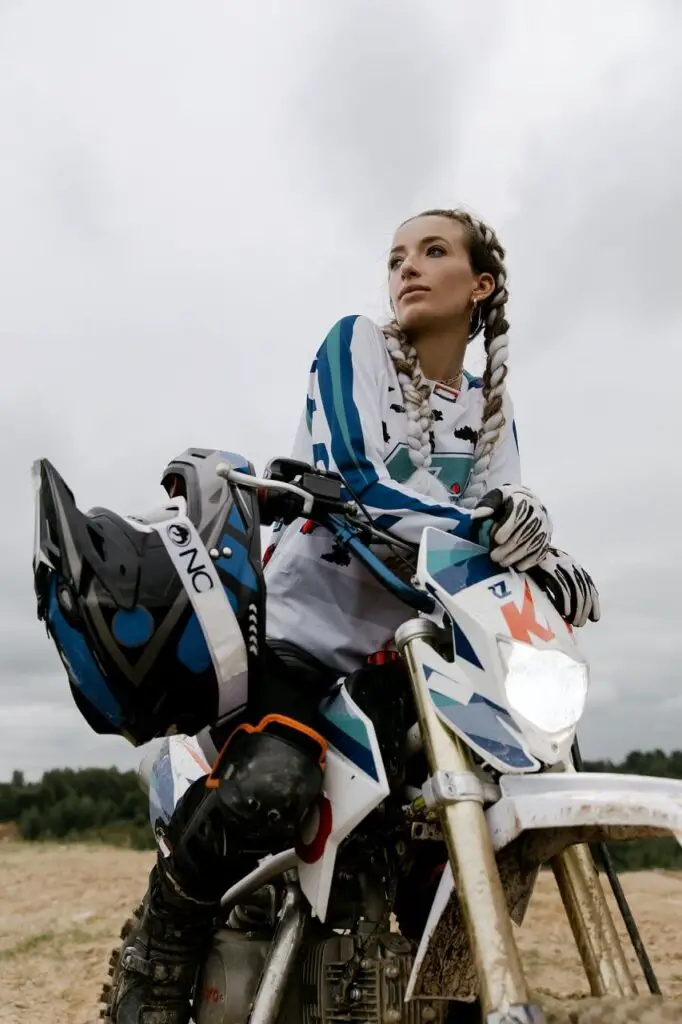
Knee guards are similar to elbow guards in design, but they’re shaped for knee protection.
They absorb the impact of falls and collisions and provide a barrier between your knee and any hard or sharp objects.
On the other hand, knee braces look like traditional braces used for nursing knee injuries, but they’re preventive measures against knee-related injuries.
They absorb impacts like knee guards with upgraded protection for your knees.
Just make sure to choose a motocross-specific knee brace that can withstand the harsh conditions of off-road riding.
Nice-to-have dirt bike gear accessories
If you want to take your protection to the next level, there are also some nice-to-have accessories you can consider:
Handguards
Handguards are like shields attached to the handlebars, keeping your hands safe from flying debris, rocks, branches, and other dangers.
They’re highly effective at preventing injuries to your hands and fingers and reducing fatigue from wind resistance during long rides.
MX socks
Unlike regular socks, motocross socks are made from high-performance materials that can withstand moisture to keep your feet dry and comfortable.
These socks are also taller than regular socks, providing extra protection and support for the lower leg, especially when wearing knee braces or guards.
Plus, they come with padding in strategic areas like the sole to provide extra cushioning and protection against impact.
Padded shorts
Impact shorts (a.k.a. padded shorts) are designed to cushion your hips, tailbone, and thighs.
This can be especially useful if you’ll ride for long periods or participate in high-impact activities like motocross or off-road racing.
Hydration pack
A hydration pack can be a game-changer, as it holds a bladder filled with water and has a hose that allows you to drink while riding.
It’s like having a portable water fountain on your back!
But if you’re just going for a quick ride or practice, a typical water bottle would suffice.
Wrapping up
Investing in essential dirt bike gear is critical for anyone who wants to enjoy their dirt biking experience while staying safe.
Each piece of gear I shared in this post will serve a purpose in protecting every part of your body from the potential risks of off-road riding.
Just remember, you want to have gear that can withstand wear and tear while providing you the protection you need.
Investing in high-quality dirt bike gear early on will be more cost-efficient than buying cheap ones. Trust me.
So before you hit the trails or the tracks, make sure you have all the essential gear from this post to stay safe and enjoy your ride to the fullest!
Sources:
- Villegas, C. V., Bowman, S. M., Zogg, C. K., Scott, V. K., Haut, E. R., Stevens, K. A., Efron, D. T., & Haider, A. H. (2016). The hazards of off-road motor sports: Are four wheels better than two?. Injury, 47(1), 178–183.
- Motocross injuries: Safety, training, and prevention: UPMC. UPMC Sports Medicine. (n.d.). Retrieved February 22, 2023, from UPMC website.
- Vittetoe KL, Allen JH, Unni P, et al. Socioeconomic factors associated with helmet use in pediatric ATV and dirt bike trauma. Trauma Surgery & Acute Care Open 2022;7:e000876. doi: 10.1136/tsaco-2021-000876
- Torrado, P., Marina, M., Baudry, S., & Ríos, M. (2021). Muscle Fatigue When Riding a Motorcycle: A Case Study. International journal of environmental research and public health, 18(15), 7738.

